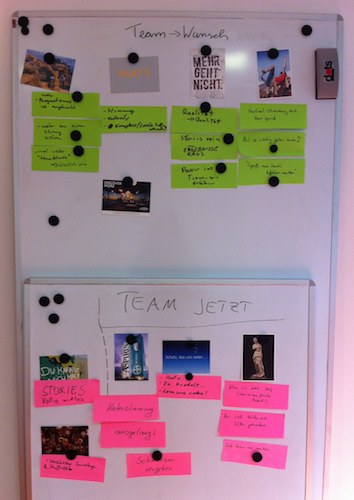Here’s another interesting question about retrospectives I got in my inbox, this time from Claudia:
I
just became a Scrum Master and will have my first Retrospective
ever. What I find difficult for the beginning – I’m sure this will
change after doing some Retros – is the transition from Set the Stage to
Gather Data. After setting the stage, how do I go the Gather Data? Do I
simply say “thank you, now, we’ll continue to gather data…“ or do I
comment anything from Set the Stage to Gather Data.
[If you are new to retrospective and have never heard about the phases you can find out more here.]
Questions
like these are great, because they make me examine something that I
don’t consciously think about and “just do”. So yeah, how do the heck do
I frame the transition? As always, the answer is: It depends 😉
It depends on what I want to achieve with “Set the Stage” (StS). Let’s look at the different cases:
Default case: I want everyone to speak, preferably about something positive and true and relevant to the last iteration
In
this case, yes, most of the time it is close to “thank you, now, we’ll
continue with gathering data…“ I wouldn’t use that exact phrasing
because it implies that the 1st phases content is throwaway, when it
reveals something about the last iteration. I can’t remember ever
picking a starting activity solely for the fun of it…
My
default opening method is a question that goes around the circle. Here
are some of these questions and a transition to “Gather Data” that lends
itself to that question:
Of
course, the transition has to also match the activity you’re leading to
in “Gather Data” (GD). But yeah, usually the sticky notes from StS just
keep hanging on a board and are not re-used. If people have the same
point again for GD, they can rewrite the sticky or re-hang the existing
sticky note. I don’t care either way.
Special case: Testing the waters – with a new team or in a conflict situation
When I facilitate for a team for the first time or in a conflict situation I like to test the waters with ESVP: Do people want to be here? How much engagement can I expect from them?
If I expect problems, I might use Constellation or Team Radar to explore questions like “How likely are you to speak openly?”. It might be necessary to adapt these to a written form that participants fill in anonymously.
The important thing is that you have to be willing to deal with problems that come up. What if half the participants are Prisoners – How will you handle it? What if nobody dares to speak openly – What will you do?
In
short, you’ll have to have at least a rough idea of a Plan B. The more
problems you expect, the more solid your Plan B needs to be.
Btw,
“normal” opening rounds and retro activities can also derail, either
because something “traumatic” happened to a single person (divorce, sick
loved one, …) or the team as a whole (someone being fired, new boss, …)
that you hadn’t been aware off. In these cases, don’t try to follow
your original plan. The retro is not an item to tick off a list. Stay
calm, sometimes it’s okay to just let people talk. But I digress …
Special case: Outcome Expectations
Related to the previous case: Some activities are about the retro on a meta level, e.g. asking for Outcome Expectations. I’ll try to help meet the expectations or at the very least check if they’ve been met or not throughout the retro.
Special case: StS is already data heavy
There are some data heavy StS activities in Retromat that can easily be fleshed out for use in GD, e.g. Amazon Review or Postcards. Don’t be limited by the phase that is assigned in Retromat. There are many activities that also fit into a different category.
Actually, when you look at my retrospectives individually, you’ll usually find only 4 to 4.5 distinct phases in them. The middle three phases kind of bleed into each other. Which one I stress varies. But whatever I do, you can spot Lean Coffee in each one of them, just rarely as a standalone technique.
(If
you plan your retrospectives with Retromat, you can get around the
strict “5 phases” layout by manually changing the IDs in the URL and
hitting enter.)
Anyway, the above are all
the special cases I can currently think of. Do you have any to add? How
do you transitien between StS and GD?
Thank you for the question, Claudia! It was fun to think about this!
PS: Did you know there's a Retromat eBook Bundle? Ready-made retrospective plans for beginners and all activities from Retromat for experienced facilitators. Check out the Retromat books







